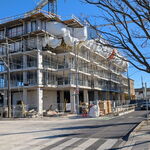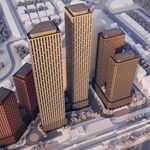Apologies. This one is a bit long.
This disinformation campaign that Toronto's residents only pitch in 15% is getting tiresome. First off, you conveniently ignore the contribution of business taxes and the fact that a good portion of the businesses in Toronto are sustained by Toronto's residents.
Well, first off, it's not a "disinformation campaign", it's an argument. It's made
here. You're free to rebut it. That's the point here. But deep breaths, okay?
The usual tag-line is about how Toronto residents are paying taxes to the TTC, and 905ers are not, so 905ers are free-riding. Well, that's just not true. Toronto residential property-holders, which is about as close as it comes, are contributing about 13% in taxes. Technically, if you are renting your dwelling then you are not contributing any property tax at all although, just like everyone else, your farebox revenues and your economic activities that supports businesses that do pay taxes, are indirect contributions.
I am not "ignoring" business taxation. In fact, I trumpet it constantly. Every 905er who makes an informed choice and takes the subway to a Toronto job, is contributing to the business taxes that go to paying for the subway. The entire GO train system is a massive infrastructure set up to ensure that employers in and around the Financial District can continue to draw in people who live in other municipalities, and can continue to pay taxes to the TTC. It is an enormous boon to Toronto. The idea that 905 salarymen working in Toronto are somehow free-riders on Toronto is just silly.
Next you ignore the fact that the vast majority of the TTC's patrons are Toronto residents.
Why on Earth would I ignore it? Seven of every 10 TTC funding dollars come from fares. Fares are paid by whoever uses the system. It's terribly egalitarian. When 905ers use it, they pay. When 416ers use it, they pay. Tourists, too. Even politicians!
The ironic thing, of course, is that 416ers' fares stretch much further than those of all the other groups I list above, because -- unlike people who do not reside in 416, and therefore only use the TTC when they get themselves to and from the 416 -- there are bus routes and so one which cater them. Those who come into the 416 just to use the system and contribute their fares
that way, in contrast, are generallly piling into the subway. The TTC doesn't have to come to them; they go to it. Higher cost recovery all 'round.
Now, to be clear, since there seems a bit of slippage here: the TTC is, indeed the Toronto municipality's transit system and noone else's, and it is up to the City of Toronto to do as it sees fit. It should be running buses all over the 416, for sure, and that's its job. I'm just trying to illustrate that it is, at least to some extent, doing that job, and that when 905ers use the TTC in order to participate in Toronto's economy, they are not the free-riders that some would like to paint them as.
So your assertion that Toronto residents only pitch in 15% of the TTC's funding is ludicrous at best. And an insulting attempt at discounting the support that the TTC gets from the residents of Toronto.
I think it will be easier for both of us if you avoid trying to read my mind or divine my intentions. I also think it would be grand if the City of Toronto decided that, as a matter of policy, the TTC -- which, to this day, is entirely a City of Toronto service and only ventures outside it when someone else picks up the tab (I do not, obviously, have a problem with this) -- was something whose operational costs they were going to pay more than 24% of, all res/bus muni taxes in. But there's for them, and you as a voter, to decide, I guess.
It should be noted too, that the TTC has far higher non-peak ridership than most cities in Canada, and I am willing to bet money that those riders are by and large local residents not suburban commuters.
Right. Well, I am also willing to bet money that a whole bunch of those are students, many of whom live in suburban areas in the 416, and in suburban areas in the 905, and in urban areas in either. But we are getting off topic here, no? What does high non-peak ridership have to do with demonstrating that my taking issue with portraying 905ers as free-riders is secretly an attempt to insult Toronto the Good?
Lastly, even if your ridiculous argument that Toronto residents only pitch in 15% was valid (It's not), that's still far more than any 905 resident is putting into the system.
Again, I do not think that you are accurately capturing what I have been saying. It is simply this: when 416ers talk loudly about how they live in Toronto and pay for the TTC with their taxes and 905ers don't, and they would really like a seat, please, and maybe the 905ers could get out of the subway and drive cars or stay home or just generally stop making those so darn crowded, they're being disingenuous. The TTC just doesn't raise more than 13% or so of its operating revenues from said taxes, and to the extent it does, 416ers nervous about not having beggared their 905 neighbours should rest assured that they do have buses and local transit that the 905ers aren't getting from the TTC so, hopefully, that 13% is going to good use.
So the priorities for the TTC should remain serving Torontonians. Last time I checked Malvern, Jane/Finch, Don Mills, Eglinton, etc were all full taxpaying Torontonians who deserve to be serviced by adequate transit. We may disagree on what that level of service should be. But surely a tax paying Malvernite should have more say than someone who merely coughs up an extra token or two on weekdays.
Absolutely. We agree on almost all of this. If the TTC wants to put up firewalls at Toronto's borders, or to decide that moving people in and around the city in order to participate in the city's economy is, in fact, undesireable, or wants to hike property tax and raise more money from sources other than fee-paying customers and hand out metropasses to Torontonians and increase fares for everyone else -- hey, that's certainly their prerogative. It might not even be a bad thing, in some instances.
But I hope you won't mind if folks dare to debate these policies. Even those aren't among the 2.5 million who live in the 416. Even those who think that the Toronto we want and need and already live in does not correspond to the magical 416-905 boundary, and that we need better regional coordination and planning and service delivery in order to better align our infrastructures and services with our lives and social networks.
The needs of the 905 should be a distant second. I stand by my assertion that if the 905 wants the TTC to become a regional service they should take it up with the province to split of the subway from the TTC. And they should take on the cost of the whole network, not just the half-dozen stations in York region. If they want to make it the Greater Toronto Transit Commission, they should go all the way.
I'm afraid you've lost me again.
First, this business about the 905 wanting the TTC to become a regional service is a bit hyperbolic, isn't it? If I live, say, a kilometre north of Steeles, and I take the family out for a bite on Steeles -- just for fun, I will not tell you whether on the north or south side -- or want to use the Goodlife at Finch station (yes, it is a whole 4 kilometres away from me), is that regional? How 'bout when I am at North York Centre? Maybe when I nip down to visit my brother at the Minto and Eglinton, am I "regional" then (and if so, do I get to ride a GO train to Eglinton?)? When you talk about the 905 needing to be a distant second and everything that happens to move between the two as being "regional" then, I'm very sorry, but to me this is the kind of thinking that does not good urban planning or placemaking make.
Second, what kind of costing are you talking about? Reading the above, I have no idea what you are railing against. Most of us are for a fair apportionment of costs, I think. Are you? If so, what is it? If 10 people get on at Steeles (ooh! border!) and 10 at Langstaff and 10 at North York Centre, are you saying you don't cost operating responsibilities at half Toronto and half York Region?
Like, is what you want to do to measure how far each of those people goes, so that if the Langstaffer heads to Union and the North York Centrer heads up to Clark and the Steeleser goes to Eglinton, you'd kind of want to count how many stops (or km, or whatever) each one goes, call that a cost-of-transit, and apportion the costs to the origin point accordingly? Because, yeah, I guess that could work (we'd have to move to a DC style fare system, mind you) but you're still stuck with what you do with return trips, and defining (for that matter) which is a return trip. Maybe all pre-noon trips get charged to the origin point, and all post-noon trips charged to the destination point? It all sounds very complicated to me -- but I'd be curious to know what it is you have in mind.




